What is asbestos?
Certifications
of Epoch Analytical Inc.
EPOCH is accredited with the US National Voluntary Laboratory Accreditation Program (NVLAP) for bulk asbestos sample analysis under NVLAP Code 200746-0.
EPOCH is accredited with the Canadian Association for Laboratory Accreditation Inc. (CALA) for airborne fiber analysis (Membership No. 3533).
1. What is asbestos?
1. What is asbestos?

Asbestos is a group of naturally occurring silicate minerals. Mined and milled from native rock, asbestos is fibrous, thin, and strong. Chrysotile, Amosite, Crocidolite, Tremolite, Anthophyllite, and Actinolite fibers are the most common types of asbestos minerals. However, only Chrysotile, Crocidolite, and Amosite varieties are of industrial importance. Characteristics, like heat resistance, chemical inertness, and insulating capacity, coupled with the flexibility to be woven make asbestos suitable for use in many industrial applications.
2. Where can I find asbestos and when can it be a problem?
2. Where can I find asbestos and when can it be a problem?
Most products made today do not contain asbestos. Those few products made which still contain asbestos that could be inhaled are required to be labeled as such. However, until the 1970s, many types of building products and insulation materials used in homes contained asbestos. Common products that might have contained asbestos in the past, and conditions which may release fibers, include:
- Steam pipes, boilers, and furnace ducts insulated with an asbestos blanket or asbestos paper tape. These materials may release asbestos fibers if damaged, repaired, or removed improperly.
- Resilient Floor Tiles (vinyl asbestos, asphalt, and rubber), the backing on vinyl sheet flooring, and adhesivesused for installing floor tile. Sanding tiles can release fibers. So may scraping or sanding the backing of sheet flooring during removal.
- Cement sheet, millboard, and paper used as insulation around furnaces and woodburning stoves. Repairing or removing appliances may release asbestos fibers. So may cutting, tearing, sanding, drilling, or sawing insulation.
- Door gasketsin furnaces, wood stoves, and coal stoves. Worn seals can release asbestos fibers during use.
- Soundproofing OR decorative material sprayed on walls and ceilings. Loose, crumbly, or water-damaged material may release fibers. So will sanding, drilling, or scraping the material.
- Patching and joint compounds for walls and ceilings, and textured paints. Sanding, scraping, or drilling these surfaces may release asbestos.
- Asbestos cemnet roofing, shingles, and siding. These products are not likely to release asbestos fibers unless sawed, dilled, or cut. artifical ashes and ember sold for use in gas-fired fireplaces. Also, other older household products such as fireproff gloves, stove-top pads, ironing board covers, and certain hairdryers.
- If asbestos containing materials are in good condition and left intact, they do not pose a significant danger of releasing asbestos fibers. These materials are only hazardous when they deteriorate or are disturbed, such as when they are handled, sanded, drilled into, or broken up so that they crumble and become friable.
3. How do asbestos fibers enter and leave the body?
3. How do asbestos fibers enter and leave the body?
IBreathing asbestos-containing air into the lungs is the exposure route of greatest concern. Some of the asbestos fibers reaching the lungs are eliminated in exhaled air and others are coughed from the lungs with mucous. The fibers reaching the deepest air passages of the lungs can produce the greatest damage.

4. How can asbestos affect my health?
4. How can asbestos affect my health?
Information on human health effects of asbestos comes mostly from long-term studies of people exposed to asbestos in the workplace. Asbestos workers who breathe in asbestos may develop a slow build-up of scar-like tissue in the lungs called asbestosis. This scarred tissue state impairs the ability of the lungs and heart to adequately provide oxygen to the body. This is a serious disease, and can eventually lead to disability or death in people exposed to high amounts of asbestos. Asbestos workers also have increased chances of developing two types of cancer: Lung cancer starts within the respiratory tissues, and mesothelial cancer grows from the thin membranes that surround the lung or the abdominal cavities. Both lung cancer and mesothelioma are usually fatal. These asbestos-related diseases do not appear immediately, but may develop 20 to 50 years after exposure.
The health effects from oral asbestos exposures are unclear. In some areas where the residents are exposed to asbestos fibers in the drinking water, cancers of the esophagus, stomach, and intestine may be a greater concern. After reviewing the scientific evidence from human experience and animal testing; however, health authorities are still unsure of asbestos links to cancer in the digestive system.
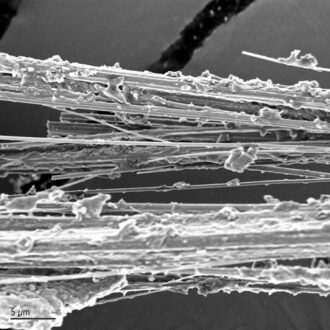
5. I have asbestos in my home. Do I need to do anything about it to protect my health?
5. I have asbestos in my home. Do I need to do anything about it to protect my health?
Most of the time, no. The common materials used in home construction are floor tile, roofing and siding. These materials are very strong and don’t readily crumble and release the asbestos fibers unless they are subjected to strong forces. Occasionally other materials such as pipe insulation and thermal insulation, such as batt or blown-in insulation, are used in home construction. If you determine that you have this type of material, through inspection and analysis by a properly qualified inspector and laboratory, you should seek the help of a consultant to aid you in determining what you need to do to remedy your situation. If you never have the need to disturb these materials, you may be able to leave them alone. But if you know that a needed repair or renovation will disturb the material, you may want to start planning with your consultant to test and abate the asbestos prior to the project.
6. What is Vermiculite and is it asbestos containing?
6. What is Vermiculite and is it asbestos containing?
Vermiculite is the mineralogical name given to hydrated laminar magnesium-aluminum-iron silicate which resembles mica in appearance. All Vermiculite ores contain a range of other minerals that were formed along with the Vermiculite in the rock. Vermiculite ores from some sources have been found to contain asbestos minerals but asbestos is not intrinsic to Vermiculite and only a few ore bodies have been found to contain more than tiny trace amounts.
Vermiculite mines are surface operations where ore is separated from other minerals, and then screened or classified into several basic particle sizes.
When subjected to heat, Vermiculite has the unusual property of exfoliating or expanding into worm-like pieces (the name Vermiculite is derived from the Latin ‘vermiculare’ – to breed worms). This characteristic of exfoliation, the basis for commercial use of the mineral, is the result of the mechanical separation of the layers by the rapid conversion of contained water to steam. During this exfoliation process, asbestos fibers, most commonly knowns as Tremolite or Actinolite, can potentially be released.
Vermiculite has been used in various industries for over 80 years. It is used in the construction, agricultural, horticultural and industrial markets. Examples of products that contain Vermiculite include potting soil mixes, loose fill insulation, and packing material. It is often used as attic insulation in homes. In BC, we have seen two main kinds of Vermiculite used as insulation in buildings: a brown/gold colour type and a white/pearl coloured type.
If you want to have the Vermiculite in your home sampled, we recommend that you hire a trained consultant or contractor to collect the sample.
When collecting a Vermiculite sample for analysis, WorksafeBC recommends 4 gallons or a large sealed zip lok bag.
It is best to collect the “ fines ” or small dust particles that settle on the bottom of a Vermiculite pile, and not just the top layer as this does not provide an accurate cross section of the material in question.
Vermiculite Float Suspension Research Method EPA 600/R-04/004 can be conducted by Polarized Light Microscopy (PLM) is conducted at our lab. If no asbestos is detected with PLM, Transmission Electron Microscopy (TEM) is recommended which has a higher precision and a far greater magnification.
Due to the physical properties of Vermiculite insulation, traditional asbestos analytical methods used for other bulk building materials do not provide the precision required for adequate quantification of asbestos fibres. Hence, WorksafeBC recommends the Vermiculite Research Method to be utilized for Vermiculite insulation analysis as per EPA method 600/R-04/004. This method is more precise and accurate due to the extraction process
Vermiculite insulation containing “ ANY % ” amount of asbestos is considered an Asbestos Containing Material and treated as a Hazardous Material. For all other building materials, WorkSafeBC’s definition of an Asbestos Containing Material (ACM), is 0.5%.
7. Where can I find out more information about asbestos in my home, business or property?
7. Where can I find out more information about asbestos in my home, business or property?
Worksafe Prevention Information Line: 1-888-621-7233 or in the lower mainland, (604) 276-3100.
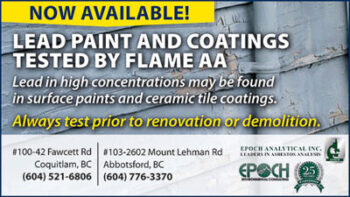
Lead (Pb) Detection by Flame Atomic Absorption Spectroscopy (FAA) NISOH 7082
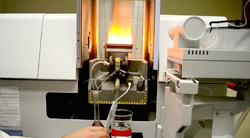
Epoch Analytical is pleased to now offer lead analysis of paints and coatings using a Flame Atomic Absorption Spectrometer. FAA analyzes lead content according to modified EPA 7000B and test method NIOSH 7082.
Using Flame AA Spectroscopy, a small quantity of sample is homogenized and microwave digested using nitric acid. The lead concentration sample is accurately determined in PPM (parts per million) using the reading from the Flame AA spectrometer following microwave digestion and dilution of a small quantity of the original sample. Please submit a sample that is no smaller than 2″x 2″ size or a minimum 100 grams in weight.
The technique is based on the principle that ground state metals absorb light at a specific wavelength. Metal ions in a solution are converted to atomic state by means of a flame. The main advantages of Flame AA include the output of highly reliable analytical results while maintaining a fast turnaround time.
To quantitatively determine the lead (Pb) content in paint and coatings, NIOSH 7082 is used. Paints chips are decomposed using mineral acids, and prepare appropriate dilutions. and measure these paint samples by aspirating them into an air-acetylene flame for atomic absorption measurement using NIOSH 7082.
Flame analysis is suitable for most analytes and matrices including paint, wipes, soils and air samples and results are reported in PPM or %. For ceramic tiles, the glazing or surface coating of the tile is analyzed for lead content using XRF Analysis.
The Limit of Detection (LOD): approx. 40 ppm or 40 mg/kg based on a 0.25g sample weight. Please submit a sample that is no smaller than 2″x 2″ in size or minimum 100 grams in weight.
Bulk Sample Asbestos Identification using EPA600/R93/116
Bulk Sample Asbestos Identification using EPA600/R93/116
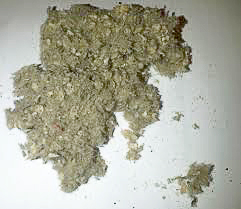
Blown Insulation
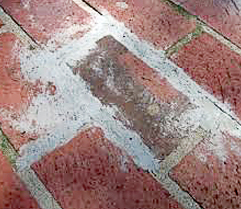
Brick Mortar
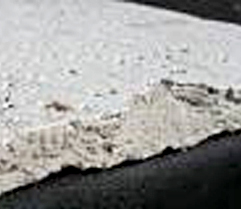
Ceiling-Tile
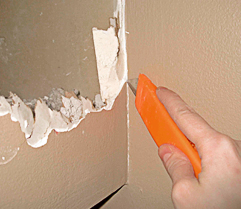
Drywall Joint Compound

Linoleum or Vinylsheet

Paper Tape
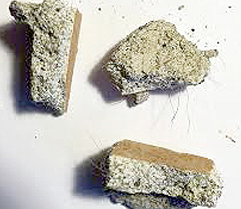
Plaster
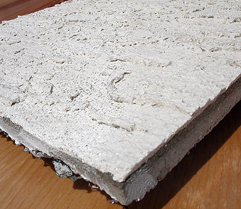
Exterior Stucco
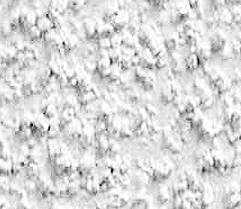
Texture Coat
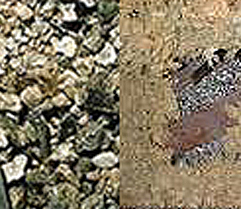
Vermiculite & Blown Insulation
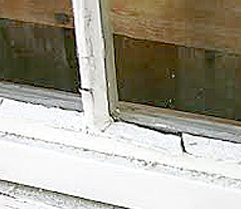
Window Putty
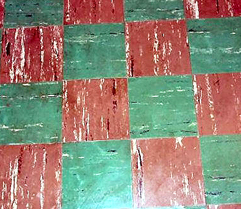
Vinyl Floor Tile
Bulk Asbestos Identification using Polarized Light Microscopy (PLM) in accordance to EPA/600/R-93/116 and EPA600/M4-82-020.
Examination of samples for asbestos content was conducted in accordance to EPA/600/R-93/116 or EPA/600/M4-82-020 methodologies using polarized light microscopy (PLM). This method is the most widely used method for estimating asbestos in bulk building materials and works well for most sample types.
Multiple layers of samples are analyzed and reported separately. All analysts are derived from calibrated visual estimate and measured in weight percent unless otherwise noted. Please note that the EPA test method has limitation for quantifying the percentage of samples with low asbestos concentration.
Transmission electron microscopy (TEM) would be encouraged for customers to obtain accurate results in these situations.
Using Stereoscopic Evaluation
All samples are analyzed first through stereo binocular examination. By magnifying a bulk sample at up to 40x, the analyst is able to evaluate and extract suspicious fibres that possess the morphological characteristics of asbestos. From there, fibres are mounted on a slide with a refractive index oil and then analyzed with the Polarized Light Microscope (PLM).

Using Polarized Light Microscopy (PLM)
Polarized light microscopy (PLM) analysis is the most commonly accepted technique for analysing bulk samples for asbestos. Identification of asbestos is based on the determination of optical properties displayed when the sample is treated with various dispersion staining liquids. Identification is further substantiated by fibre morphology and the effect of polarized light on the fibres. PLM analysis is specific to fibrous materials and allows for the determination of:
There are 6 types of Asbestos
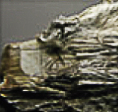
Chrysotile
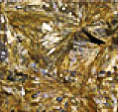
Amosite
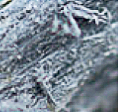
Crocidolite

Tremolite
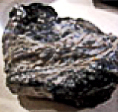
Anthophyllite
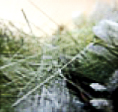
Actinolite
Asbestos Type: There are six (6) types (Chrysotile, Amosite, Actinolite, Tremolite, Crocidolite Anthophylite);
Quantification: % amount of asbestos and non-asbestos fibers in the sample quantified by Calibrated Visual Estimate of the analyst;
Fiber Colour under microscopic evaluation;
None Detected : Means No Asbestos Present in sample
Airborne Asbestos Fiber Counting using Phase Contrast Microscopy (PCM) in accordance to NIOSH 7400
Airborne Asbestos Fiber Counting using Phase Contrast Microscopy (PCM) in accordance to NIOSH 7400
In testing for asbestos, air is drawn through a filter. This filter is usually a part of a 25-mm cassette that can take specific sampling times. The sampling time is chosen to produce a fiber density of between 100 to 1,300 fibers/mm2; this rate is usually 0.5 to 16.0 liters/minute. The filter is then analyzed by phase contrast microscopy (PCM) or transmission electron microscopy (TEM). Fibre counting analysis is conducted in accordance to The National Institute for Occupational Safety and Health (NIOSH) Method #7400.

Enlarged Asbestos Fibers
The National Institute of Occupational Safety and Health (NIOSH) method 7400
The analysis includes testing of air sample for asbestos and other fibers by PCM. It is used primarily for estimating asbestos concentrations in air. The method does not differentiate between asbestos and other fibers and can also be used to estimate the airborne concentration of other, non-asbestos materials such as fibrous glass. Fibre less than 0.25 microns in diameter will not be detected with this method.

The National Institute of Occupational Safety and Health (NIOSH) method 7402
NIOSH 7402 is fibre specific and can be utilized to complement the phase contrast microscopy method 7400. It can determine the fraction of asbestos fibres among all optically visible fibres within a given sample. The results can be used to calculate a modified PCM fibre count.
PCM works well for testing airborne fibers because it is relatively inexpensive and quick. However, PCM does not differentiate between asbestos and other fibers. All fibers that meet the counting criteria are counted. Transmission Electron Microscopy (TEM) is encouraged for customers to obtain more accurate results where precise determination of airborne asbestos fiber is needed.
Gravimetric 400 and 1000 Point Count for Bulk Asbestos
Gravimetric 400 and 1000 Point Count for Bulk Asbestos
Gravimetric point counting is a technique that enhances quantification of asbestos in bulk building materials.The sample is first dried and then weighed. It is then subjected to high temperature in an ashing furnace for a period of approximately 6 hours. During this process organic material is oxidized (burned). After cooling the sample is re-weighed and the weight loss recorded.
Further treatment with dilute hydrochloric acid may be used to remove carbonates and other acid soluble substances in the sample. The remaining material is then washed with plain water, dried and weighed. This weight loss is also recorded. The residue is now examined and PLM point counting is performed to determine the concentration of asbestos fibers in the residue. Because we know the weight of the residue we can calculate the concentration of asbestos in the original sample.
Gravimetric point count improves the ability to detect asbestos fibers in the sample and also improves the quantification. This is so because the residue is very often granular particulates rather than a wide variety of materials with vastly different density and mass thereby making more representative slides and improving point counting statistics.
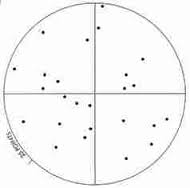
Point counting does not apply to the EPA vermiculite method.
The Asbestos 400 Point Count reporting limit is <0.25% and Asbestos 1000 Point Count reporting limit is <0.1%.
Vermiculite Research Method by PLM using EPA600/ R-04/004
Vermiculite Research Method by PLM using EPA600/ R-04/004
Vermiculite is a mineral which was commonly used as insulation in buildings, amongst other commercial and consumer products. While not all vermiculite may contain asbestos fibers, it is reasonable to assume that older vermiculite insulation should be analyzed by an accredited asbestos laboratory. WorkSafeBC recommends that the Vermiculite Research Method, EPA/600/R04-004, otherwise known as the “Cincinnati Method”, be utilized. Regular analysis by Polarized Light Microscopy (PLM) using EPA/600/R93/116 may not be adequate to detect asbestos amphiboles from an insufficient sample size to determine the presence or absence of asbestos, the Cincinnati Method is more precise and accurate due to a two-step extraction process using water to separate the amphibole asbestos fibers.
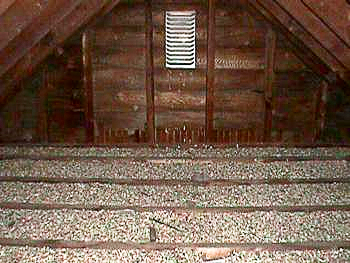
If NO asbestos amphiboles are detected in the fractions, Transmission Electron Microscope (TEM) is the final step of analysis to confirm the presence or absence of asbestos. Any % amount of asbestos detected in vermiculite, is considered an Asbestos Containing Materials (ACM) according to WorkSafeBC. Please submit at least 4 gallons or a full 6″x7″ zip lock large freezer bag of vermiculite for analysis – an insufficient quantity of vermiculite may be rejected and will delay analysis.
Lead Detection in Paints and Coatings
Lead Detection in Paints and Coatings
Until the 1980s, lead was used in paint because of its increased durability, ability to make colours more vibrant, and help paint dry faster. Lead-containing paints and coatings do not present a hazard if they are left intact. The health risk occurs when the paint chips, peels or is otherwise damaged and lead dust, mist or fumes are released into the work environment. Inhalation and ingestion of lead in the smallest of quantities, particularly by children, can be deadly.
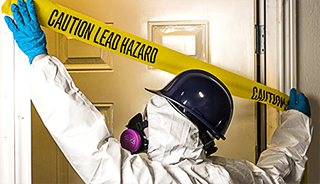
Please be aware WorkSafeBC does not numerically define what would be considered a Lead containing or lead based paint or coating. The lead content of paint must be determined as part of the risk assessment by a qualified professional. Please submit a sample that is no smaller than 3″x 3″ in size in a zip lock bag. coatings” For ceramic tiles, the glazing or surface coating of the tile is analyzed for lead content.
Please be aware WorkSafeBC does not numerically define what would be considered a lead containing or a lead based paint or coating. Any amount of lead in a material may pose an exposure risk to workers when the material is disturbed, depending on the method. Any risk assessment should include the presence of high risk individuals, especially pregnant women and children, within the workplace.
For more information about lead exposure and recommendations on providing suitable safe work procedures, please refer to the WorkSafeBC publication, Safe Work Practises for Handling Lead (2017).
At Epoch Analytical Inc we can test lead content in Paints and Coatings using two different methods.
Lead (Pb) Detection by Open Beam X-Ray Fluorescence (XRF) Analysis
Lead (Pb) Detection by Open Beam X-Ray Fluorescence (XRF) Analysis
EPOCH uses Open Beam X-Ray Fluorescence (XRF) technology to conduct our lead testing methods as a fast (immediate), non-destructive technique of testing for lead in surface paints and coatings. The XRF analyzer measures the amount of lead in paint and other surface coating by exposing a painted or coated surface to X-rays or gamma radiation, which then causes any lead present to emit energy with a certain frequency.

The results from XRF analysis can be reported in either volume as ppm (parts per million) or surface area as mg/cm2. Please submit a bulk sample of paint that is at least 2-3 inches in surface area. Lead surface wipes can also be analyzed by XRF. Please be sure to
The limit of detection (LOD) using XRF for volume is approximately < 20 ppm or mg/kg.
Our technicians are certified XRF analyzer operators and have acquired a Level 1 X-ray Fluorescence Analyzer Operator Certificate issued by the Natural Resources Canada (NRCan).
Lead (Pb) Detection by Flame Atomic Absorption Spectroscopy (FAA) NISOH 7082
Lead (Pb) Detection by Flame Atomic Absorption Spectroscopy (FAA) NISOH 7082

Epoch Analytical is pleased to now offer lead analysis of paints and coatings using a Flame Atomic Absorption Spectrometer. FAA analyzes lead content according to modified EPA 7000B and test method NIOSH 7082.
Using Flame AA Spectroscopy, a small quantity of sample is homogenized and microwave digested using nitric acid. The lead concentration sample is accurately determined in PPM (parts per million) using the reading from the Flame AA spectrometer following microwave digestion and dilution of a small quantity of the original sample. Please submit a sample that is no smaller than 2″x 2″ size or a minimum 100 grams in weight.
The technique is based on the principle that ground state metals absorb light at a specific wavelength. Metal ions in a solution are converted to atomic state by means of a flame. The main advantages of Flame AA include the output of highly reliable analytical results while maintaining a fast turnaround time.
To quantitatively determine the lead (Pb) content in paint and coatings, NIOSH 7082 is used. Paints chips are decomposed using mineral acids, and prepare appropriate dilutions. and measure these paint samples by aspirating them into an air-acetylene flame for atomic absorption measurement using NIOSH 7082.
Flame analysis is suitable for most analytes and matrices including paint, wipes, soils and air samples and results are reported in PPM or %. For ceramic tiles, the glazing or surface coating of the tile is analyzed for lead content using XRF Analysis.
The Limit of Detection (LOD): approx. 40 ppm or 40 mg/kg based on a 0.25g sample weight. Please submit a sample that is no smaller than 2″x 2″ in size or minimum 100 grams in weight.
Mold and Bacteria Analysis
Mold and Bacteria Analysis
Accurate identification of molds is important. It helps alleviate unnecessary concern and aids in decision-making.
Suitable samples for mold testing include:
• Pieces of material with signs of mold.
• Tape lift or swab samples taken from surfaces suspected of mold.
• Air samples: These include non-viable and viable samples.
Mold testing involves analysis of samples collected from residential and commercial properties. Samples for mold testing include air for either viable or non-viable analysis and surface samples such as swabs, bulk (pieces of material, dust or liquids), tape lift, and contact plates.
Direct Microscopic Examination (DME) is using x400, x600, or x1000 magnification as necessary.
Culture and quantification is also available. Mold and Bacteria Analysis is conducted by trained microbiologists from an accredited laboratory.
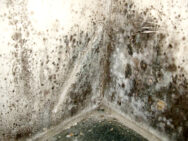
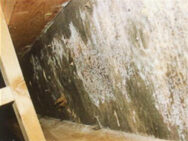

Transmission Electron Microscopy (TEM)
Transmission Electron Microscopy (TEM)
What you can see with a light microscope is limited by the wavelength of light. TEM uses electrons as a “light source” and their much lower wave length makes it possible to get a resolution at A higher magnification (up to 20,000x and higher) and identifies asbestos fibers by morphology, crystalline structure and elemental analysis.
As there are no TEM laboratories in western Canada, Epoch Analytical will facilitate and coordinate the sending of samples to an accredited laboratory for TEM analysis.











